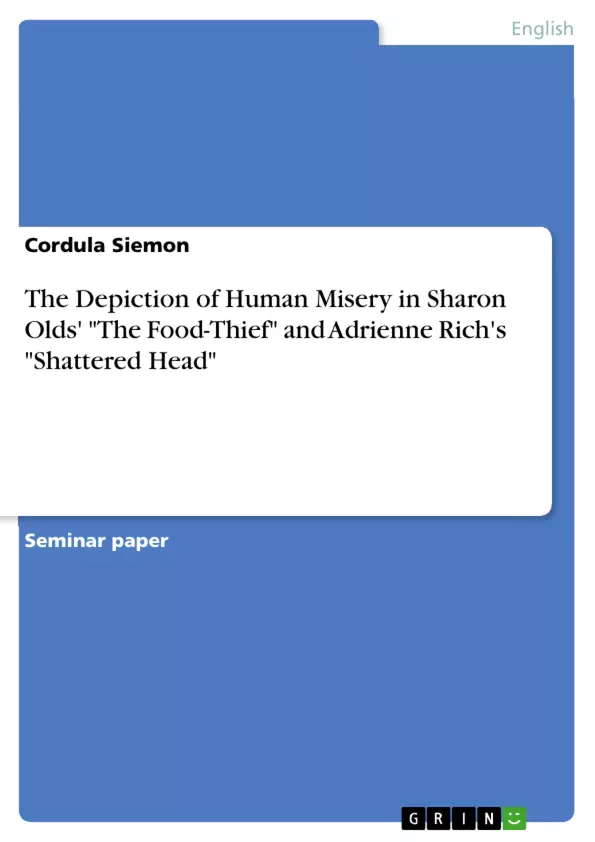When it comes to women's poetry in the 20th and 21st centuries, Sharon Olds and Adrienne Rich are two of the most accomplished poets of our time. Rich became famous in the 1960s and 1970s for her engagement in (feminist) politics, as an activist, strongly committed to the use of poetry as an instrument of social change. Olds, who was born thirteen years after Rich, is not so much known for her political engagement but rather her obsession with “the foodlike and procreative possibilities of human bodies,” and her love for “images of animals, soil, blood and eggs” (Ostriker 242). The sometimes physical aggressiveness of her style and provocative poems like “The Pope's Penis” have even earned her a reputation for being pornographic.
Human misery as a topic in poetry is probably as old as the genre of poetry itself, but what can be of particular interest is how such a seemingly basic human condition can be used poetically to bring across different messages. In the following analysis of Rich's poem “Shattered Head” and Olds's “The Food-Thief”, I will exemplify how the contrasting depictions of human misery were used by the poets to convey their very different political attitudes.
Inhaltsverzeichnis (Table of Contents)
- Introduction
- Sharon Olds: "Food-Thief"
- Setting
- Formal Analysis
- Stylistic Devices
- Water Imagery
- Repetition
- Moral Complexity
- Adrienne Rich: "Shattered Head"
- Setting
- Formal Analysis
- Stylistic Devices
- Nature Imagery
- Images of Blood
- Repetition
- The Quest for Truth
- Conclusion
Zielsetzung und Themenschwerpunkte (Objectives and Key Themes)
This analysis examines the contrasting depictions of human misery in Sharon Olds's "The Food-Thief" and Adrienne Rich's "Shattered Head" to illustrate how the poets convey their differing political attitudes. The analysis focuses on the formal elements, stylistic devices, and thematic complexities within each poem.
- The portrayal of human misery as a poetic device for conveying different messages
- The contrasting political attitudes of Sharon Olds and Adrienne Rich
- The use of stylistic devices to highlight the intertwining of nature and human experience
- The exploration of moral complexity in the face of suffering and deprivation
- The connection between the themes of food, water, and life in "The Food-Thief"
Zusammenfassung der Kapitel (Chapter Summaries)
The introduction provides context for the analysis by briefly introducing Sharon Olds and Adrienne Rich as prominent poets in the 20th and 21st centuries, highlighting their differing approaches to poetry and engagement with social issues. It then introduces the topic of human misery as a prevalent theme in poetry and how it can be used to convey diverse perspectives.
The chapter on "The Food-Thief" delves into the setting, formal analysis, stylistic devices, and moral complexity of Olds's poem. It examines the poem's free verse structure and use of run-on lines to reflect the relentless suffering of the food-thief. The analysis explores the poem's extensive use of water imagery as a contrast to the drought and its connection to themes of food and life. The chapter also analyzes the repetition of key phrases and words to emphasize the ongoing processes of driving, beating, and eating, highlighting the poem's exploration of moral complexity and the intertwining of darkness and light in human life.
The chapter on "Shattered Head" (not included) focuses on the setting, formal analysis, stylistic devices, and exploration of the quest for truth in Rich's poem.
Schlüsselwörter (Keywords)
This analysis focuses on the themes of human misery, political engagement, stylistic devices, water imagery, repetition, moral complexity, nature imagery, and the contrasting perspectives of Sharon Olds and Adrienne Rich in their poems "The Food-Thief" and "Shattered Head."
- Citation du texte
- Cordula Siemon (Auteur), 2008, The Depiction of Human Misery in Sharon Olds' "The Food-Thief" and Adrienne Rich's "Shattered Head", Munich, GRIN Verlag, https://www.grin.com/document/157001



